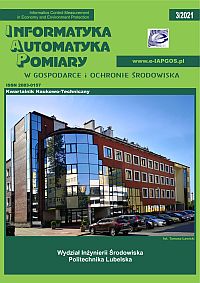CUSTOMIZATION BASED ON CAD AUTOMATION IN PRODUCTION OF MEDICAL SCREWS BY 3D PRINTING
Article Sidebar
Open full text
Issue Vol. 11 No. 3 (2021)
-
USING STEALTH TECHNOLOGIES IN MOBILE ROBOTIC COMPLEXES AND METHODS OF DETECTION OF LOW-SIGHTED OBJECTS
Andrii Rudyk, Andriy Semenov, Olena Semenova, Sergey Kakovkin4-8
-
SMART POWER WHEELCHAIR: PROBLEMS AND CHALLENGES OF PRODUCT APPROACH
Serge Ageyev, Andrii Yarovyi9-13
-
IMPROVING THE ACCURACY OF VIBRATION MEASUREMENT RESULTS
Anzhelika Stakhova, Volodymyr Kvasnikov14-17
-
CUSTOMIZATION BASED ON CAD AUTOMATION IN PRODUCTION OF MEDICAL SCREWS BY 3D PRINTING
Piotr Bednarczuk18-21
-
METHOD AND GAS DISCHARGE VISUALIZATION TOOL FOR ANALYZING LIQUID-PHASE BIOLOGICAL OBJECTS
Yaroslav A. Kulyk, Bohdan P. Knysh, Roman V. Maslii, Roman N. Kvyetnyy, Valentyna V. Shcherba, Anatoliy Ia. Kulyk22-29
-
OVERVIEW OF SKIN DIAGNOSTIC TECHNIQUES BASED ON MULTILAYER SKIN MODELS AND SPECTROPHOTOMETRICS
Magdalena Michalska30-33
-
DYNAMIC HANDWRITTEN SIGNATURE IDENTIFICATION USING SPIKING NEURAL NETWORK
Vladislav Kutsman, Oleh Kolesnytskyj34-39
-
GRANULAR REPRESENTATION OF THE INFORMATION POTENTIAL OF VARIABLES - APPLICATION EXAMPLE
Adam Kiersztyn, Agnieszka Gandzel, Maciej Celiński, Leopold Koczan40-44
-
INFLUENCE OF A PLATFORM GAME CONTROL METHOD ON A PLAYER’S EFFECTIVENESS
Bartosz Wijatkowski, Jakub Smołka, Maciej Celiński45-49
-
A REVIEW OF CURRENTLY USED ISOLATED DC-DC CONVERTERS
Damian Dobrzański50-54
Archives
-
Vol. 13 No. 4
2023-12-20 24
-
Vol. 13 No. 3
2023-09-30 25
-
Vol. 13 No. 2
2023-06-30 14
-
Vol. 13 No. 1
2023-03-31 12
-
Vol. 12 No. 4
2022-12-30 16
-
Vol. 12 No. 3
2022-09-30 15
-
Vol. 12 No. 2
2022-06-30 16
-
Vol. 12 No. 1
2022-03-31 9
-
Vol. 11 No. 4
2021-12-20 15
-
Vol. 11 No. 3
2021-09-30 10
-
Vol. 11 No. 2
2021-06-30 11
-
Vol. 11 No. 1
2021-03-31 14
-
Vol. 10 No. 4
2020-12-20 16
-
Vol. 10 No. 3
2020-09-30 22
-
Vol. 10 No. 2
2020-06-30 16
-
Vol. 10 No. 1
2020-03-30 19
-
Vol. 9 No. 4
2019-12-16 20
-
Vol. 9 No. 3
2019-09-26 20
-
Vol. 9 No. 2
2019-06-21 16
-
Vol. 9 No. 1
2019-03-03 13
Main Article Content
DOI
Authors
piotr.bednarczuk@wsei.lublin.pl
Abstract
The paper presents a proposal of a complete CAD Automation solution enabling customization of the production of medical screws to individual patient requirements. The proposed approach using OLE technology enables the introduction of customization at the CAD project stage. The assembly of the surgical screw in the PLM system is generated by means of a specially developed application. The application communicates with the SolidEdge system using an API, taking into account 10 different input parameters. Three different types of medical screws have been developed in the application: the Herbert Screw, Cancellous Screw, and Malleolar Screw with three different thread types: rectangular, isosceles, and trapezoidal. The screws designed in this way can be manufactured using 3D printing techniques or CNC machining, and can be used for both humans and animals.
Keywords:
References
Amadori K., Tarkian M., Tarkian J., Ölvander J., Krus P.: Flexible and robust CAD models for design automation. Advanced Engineering Informatics 26(2), 2012, 180–195. DOI: https://doi.org/10.1016/j.aei.2012.01.004
DeCoster T. A., Heetderks D. B., Downey D. J., Ferries J. S., Wendell J.: Optimizing Bone Screw Pullout Force. Journal of Orthopaedic Trauma 4(2), 1990, 169–174. DOI: https://doi.org/10.1097/00005131-199004020-00012
Evans B.: Practical 3D Printers: The Science and Art of 3D Printing. Apress, 2012. DOI: https://doi.org/10.1007/978-1-4302-4393-9
Putman A. C., Willmert K.: Automation of Solid Edge Using External Clients Written in C++. AMO – Advanced Modeling and Optimization 13(3), 2011, 499–538.
Solid Edge .Net Programmer’s Guide, Siemens Product Lifecycle Management. 2008.
Thomas D., Singh D.: 3D Printing in Medicine and Surgery. Elsevier, 2019.
Viezens L. et al.: Impact of Screw Diameter on Pedicle Screw Fatigue Strength – A Biomechanical Evaluation. World Neurosurgery 152, 2021, e369–e376. DOI: https://doi.org/10.1016/j.wneu.2021.05.108
Weller C., Kleer R.: Economic Value of Digitized Manufacturing: Product Customization with 3D Printing. Academy of Management Proceedings 1, 2015, 11524. DOI: https://doi.org/10.5465/ambpp.2015.11524abstract
Wilkie J., Docherty D. P., Möller K.: Developments in Modelling Bone Screwing, Current Directions in Biomedical Engineering 6(3), 2020, 111–114.
Wilkie J., Docherty P. D., Möller K.: Developments in Modelling Bone Screwing. Current Directions in Biomedical Engineering 6(3), 2020, 111–114. DOI: https://doi.org/10.1515/cdbme-2020-3029
Wu Z., Nassar S., Yang X.: Axial Fatigue Performance of Medical Screws in Synthetic Bone. International Journal of Biomedical Engineering and Technology 17(2), 2015, 192–207. DOI: https://doi.org/10.1504/IJBET.2015.068059
.NET Programmers’s Guide, Solid Edge with Synchronous Technology API. Siemens PLM Software, 2008.
Article Details
Abstract views: 403
License

This work is licensed under a Creative Commons Attribution-ShareAlike 4.0 International License.






